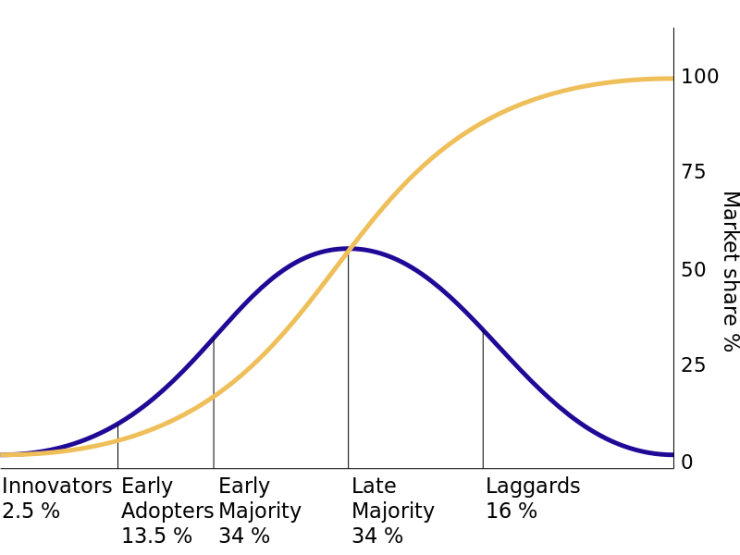Diffusion of Innovation
Transformation of an existing software development organization, to practice and embrace agile, is more than flipping teams. It is a commitment to adopt an alternative thought process, and practices focused on continuous improvement.
One of the disciplines that we used, to win the hearts and minds of individuals within the organization, was to address agile transformation as the diffusion of an innovative thought.
Diffusion of innovations[1] is a model presented by Everett M. Rogers and defines diffusion as the process by which (1) an innovation (2) is communicated through certain channels (3) over time (4) among the members of a social system.

Figure 1: The diffusion of innovations according to Rogers. The curve is broken into sections of adopters.
Communicating messages effectively to the masses is something that we excelled in at Ayna. We had used the diffusion model, as early as 2001, to grow our online communities past the two million users mark. Diffusion allowed us to communicate changes in ways that increased trust in the brand and accelerated adoption of new features.
I will highlight the slight differences in how diffusion was applied to the organization, in comparison with our practices when engaging online communities.
Innovation— Rogers defines an innovation as an idea, practice or objective that is perceived new by an individual, regardless of when it was created. It is also important to note that an individual could have known about an innovation for some time, but has not developed a favorable or unfavorable attitude towards it.
Our online innovations included everything from communities to allow members to freely express their thoughts, connect and built personal relationships, and to the ability to find resources beyond what was possible then.
Our organizational innovation was built around differentiation around our technology and operational value chains[2] by adoption Scrum.
Channels of Communication— Generally we recognized two types of communications (1) direct and (2) indirect, whereas:
Direct communication, any person can purposefully initiate a direct communication with someone, using any of the available channels, and this the primary mode of communication for most of us.
Online we used email, forums, chat and personal interactions to connect with customers.
Internally, we relied on face to face meetings, email, Wikis, chats, committees, etc.
In both cases, all our communication channels were optimized for two-way communication.
Indirect communication, occurs whenever a person performs an action, or decides not to act, in response to a decision, which can be observed through passive observation or empirical analysis.
Online we inferred what our communities liked or disliked by examining web traffic and analyzing interaction reports.
Internally, we found the same trends but they manifested themselves in grapevines, taking certain actions versus others, and by tracking what Scrum resources were tapped or ignored.
In both cases, we could use A/B testing to gauge success, and by observing the organic growth of communities around the innovations.
Time – Organizational responsiveness to external and internal stimuli can be the difference between success and failure of a business.
Scrum made it possible for the company to address the “time” variable in the diffusion model for both our external and internal needs. (1) by being more responsive our customers and (2) by able to quickly react to the needs of business and become hyper competitive.
To communicate innovation to our audience, we selected the five-stage Innovation-Decision Process[3] proposed by Rogers.

Figure 2: Innovation-Decision process proposed by Roger where an individual pass from first knowledge of innovation, to forming an attitude towards the innovation, to adopt or reject, to implement the new idea, and to confirm the decision.
Online we did not feel that time was critical, given that as a startup practicing Scrum, we were providing incremental value at higher rates compared to our competitors.
Internally it was a different story. We were confronted with power struggles stemming from fear of individuals who had already formed a negative opinion about Scrum, and were actively disrupting decision process. I would experience this type of guerrilla maneuvers in other organizations undergoing agile transformations.
We found out that adoption had better success rate when the information required for these stages were provided at higher speeds that the existing ones.
Social Systems – Online communities at ayna.com were amazing, and vibrant social systems that emerged from individuals’ need to connect beyond their national borders and interact with Arabic speaking users anywhere in the world.
During the early days of the startup, I interacted with thousands of individuals online, learning about their fears, values, and aspirations. I ensured that Ayna’s platform would provide an online experience that shielded them from prying eyes and provided them with a safe place to interact and gain insight, while learning and exploring the new world wide web.
Within the company, we had similar flavors of what we saw online. People wanted to belong to a company that was providing them with learning and career opportunities within a safe environment. Transparency at all levels made it difficult for sub-groups to thrive, and our learning focus made it ok to fail and learn from those mistakes.
[1] Diffusion of Innovation, Everett M. Rogers, 5th edition, Free Press, 2003
[2] Competitive Advantage, Creating and Sustaining superior performance. Michael E Porter, Free Press 1985.
[3] Rogers, Everett M. "The Innovation-Decision Process." Diffusion of Innovations. New York: Free, 2003. 168-218. Print.
